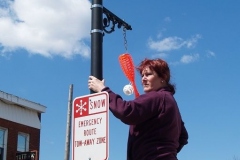no images were found
This Saturday, the Wells Corridor Business Association will sponsor their first annual William Wells Day at the foot of the historic Wells Street Bridge.
Events scheduled include:
- 4 pm to 8 pm
- Boat Tours
- Face Painting
- Puppet Show
- Arts & Crafts
- Arrowhead Making
- Chainsaw Artist Scott Lepley
- 4:30 pm to 7 pm
- Karate Demonstration by Basche School of Martial Art
- 5 pm to 6 pm
- Family Canoe Races
- 6 pm to 6:30 pm
- Watermelon Eating Contest
- 6 pm to 7:30 pm
- Storytellers including author Joe A. Krom
- 6 pm to 10 pm
- Live music with The Afrodisiacs
- 6:30 pm
- Auction for Windows of Wells Artwork
- 8 pm
- Lighting of the Bonfire & Cauldrons of Fire
- 8:30 pm
- Drummers and Dancing
For a little background on William Wells, we’ll turn to his ARCH Marker which is located at the northeast corner of of the Griswold Drive and Tennessee Avenue intersection.
Text of the marker:
William Wells
A tract of 320 acres of land extending west of the St. Joseph River (the modern Bloomingdale and Spy Run neighborhoods) was set aside by an act of Congress in 1808 for the Indian agent William Wells in recognition of his many services to the U. S. government. This act established Well’s right to occupy and develop the land with an option to buy at $1.25 per acre (rather than having to bid for the land, as was usually the case) when the area was opened for sales by the U. S. Land Office. Wells created on these lands a farm that was worked by 12 African-Americans, who were held as slaves through life-time indentures, contrary to the prohibition against slavery declared in the Northwest Ordinance.
William Wells had been captured as a sixteen-year-old by Miami warriors raiding in Kentucky. He was adopted by Chief Graviahatte (the Porcupine), taught Indian ways, and, because of his red hair, given the name Apekonit (Wild Carrot). Wells married Manwangophath (Sweet Breeze), the daughter of war chief Little Turtle, and participated in the early battles led by his father-in-law against the United States forces.
In 1794, Wells changed sides and served Gen. Anthony Wayne as his “chief of spies,” or head scout, in the general’s campaign against Indian resistance, which reached a climax on August 20 at the Battle of Fallen Timbers.
Wells had a stormy career as Indian agent and interpreter in the many negotiations between the Indians and the government; between 1796 and 1809 he accompanied Chief Little Turtle on his four trips to the nation’s capital.
Wells was killed by Potawatomi Indians in battle near Fort Dearborn (Chicago) in 1812 at the outbreak of the War of 1812. He had left Fort Wayne to try to lead the Fort Dearborn occupants, which included his niece, to safety. After he was killed, the Potawatomi ate his heart in the warriors’ belief that they would gain Wells’s renowned courage.
















